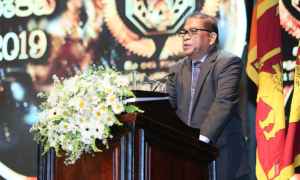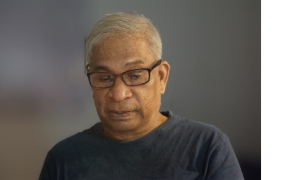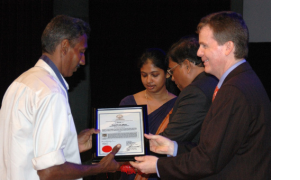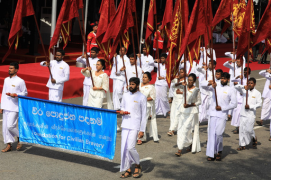
Nov 26 2024.
views 166In a bustling corner of Colombo, amidst the usual clamour of the Pettah market in 1991, a simple moment sparked a profound mission to honour acts of extraordinary bravery performed by ordinary people. Philip Chandraratne, the founder of the Foundation of Civilian Bravery, was walking along the pavement when he stumbled upon two copies of Reader’s Digest for just two rupees. One of the magazines contained a story that would alter the course of his life—a powerful narrative about a young girl who saved her father from a fatal accident, later being recognized with the prestigious Carnegie Medal of Bravery by none other than President Ronald Reagan. In that moment, Chandraratne was inspired to create a similar system of recognition closer to home.

"I was already familiar with acts of bravery among rural folk in Sri Lanka," says Chandraratne. "But seeing this story sparked something deeper. I thought, why not have a way to recognise those heroes among us, who go unnoticed?". His thoughts quickly transformed into action. A letter to Reader's Digest led him to the Carnegie Hero Fund Commission in the United States, where he received guidance from Walter Rutkowski, the Commission's then-secretary, who helped Chandraratne formulate the guidelines for the first-ever Civilian Bravery awards in Sri Lanka.
The awards were launched in 1993, and since then, the Foundation of Civilian Bravery has been on a mission to honour everyday heroes who risk their lives for others.
A Hero’s Sacrifice
The first recipient of the Gold Medal of Civilian Bravery awarded posthumously, embodied the very essence of selflessness that Chandraratne sought to recognise. In October 1993, on the Ukwatta Ferry near Kalutara, a 73-year-old ferryman named Seneris was caught in a sudden storm. As the ferry capsized, throwing six women passengers into the turbulent river, Seneris—despite his age and lack of formal rescue training—rushed to their aid. He managed to save five women, but when he attempted to rescue the last, a young woman swept away by the current, both she and Seneris perished in the river.
"Seneris's sacrifice was the perfect embodiment of civilian bravery," Chandraratne recalls. "He had no formal training, no expectation of recognition, but his selflessness cost him his life. That is the kind of heroism we want to honour."
In 1993, Seneris was posthumously awarded the first Gold Medal of Civilian Bravery at the Ukwatta Gangasiri Temple, in a ceremony attended by district officials. The award was presented by Justice R. N. Dheeraratne, a moment that set the tone for what would become an annual tradition recognising unsung heroes across the island.
The Process: Identifying Heroes in the Community
The process of identifying such individuals begins each year with an open call for nominations through media releases in all three of Sri Lanka’s main languages. But recognising bravery isn't as simple as receiving nominations. "We have an interview board that reviews every application carefully," explains Chandraratne. "The board includes distinguished individuals, such as former Chief Justice Asoka de Silva and military leaders, ensuring credibility and impartiality in our process."
Once nominations are received, the committee conducts thorough investigations, often working with local police and other authorities to verify the incidents and ensure that the bravery showcased is indeed deserving of recognition.

Yet even with a structured process in place, finding the right nominees isn’t always easy. "What we see is that these acts of bravery often go unnoticed," says Chandraratne. "People in rural communities, especially those from lower socioeconomic backgrounds, are less likely to be recognized in the traditional sense. But they are the ones who often make the greatest sacrifices."
A Hero from Kandy: The Story of Sekan Sathyamoorthi
One such hero was Sekan Sathyamoorthi, a humble toilet cleaner from Mahaiyawa in Kandy, whose heroism in 2005 serves as a reminder of the extraordinary acts that can come from the most unlikely places. On December 31, Sathyamoorthi was working at a local hotel when he noticed thick smoke rising from a nearby two-story building. When he reached the scene, the building was engulfed in flames, and bystanders were helplessly watching the fire consume the structure. Inside, two young children remained trapped.
Without hesitation, Sathyamoorthi made his way into the building, braving the intense heat and smoke to rescue the unconscious children. He saved one, but upon hearing that the other child was still inside, he risked his life again to rescue the second child, returning to the burning building even though he feared he might not make it out alive.
His bravery did not go unnoticed. In 2006, Sathyamoorthi was awarded the Gold Medal of Civilian Bravery, presented by the British High Commissioner. The highlight of the ceremony was when the two children he had saved stood alongside him on stage, forever linked by his selflessness.
Bravery in a Society Resistant to Change?
Chandraratne’s efforts to celebrate civilian bravery have faced many challenges, particularly in a society that has long placed the concept of heroism on the shoulders of the elite. "In Sri Lanka, like many other Asian countries, the hero is traditionally seen as someone from the upper echelons of society—someone who has power, prestige, and influence," Chandraratne explains. "The idea of recognising everyday people as heroes was not something that society was accustomed to."

This resistance to recognising ordinary heroes was evident in the early stages of Chandraratne’s work. He recalls one incident where a news headline misinterpreted an act of bravery, calling it “The Elephant Runs Seeing Nudity.” The story, however, was about a farmer who had saved a doctor from an attacking elephant by shedding his sarong, a custom meant to distract the animal. "It was a common act of bravery," says Chandraratne. "But the public couldn’t see it that way. They thought it was too 'ordinary.'"
However, times have changed. With annual award ceremonies held at prestigious venues like the BMICH in Colombo, the concept of honouring civilian bravery has gained traction. Chandraratne believes that the increasing recognition of these heroes has led to a shift in the public's perception of bravery. "What we are witnessing now is a slow, but steady, shift," he says. "People are beginning to realise that bravery doesn’t only come from the elite or the military—it can come from anyone, anywhere."
The Struggles of Sustaining a Non-Governmental Initiative
However, Chandraratne’s journey hasn't been without its struggles. Financing the awards ceremony each year has been a significant challenge. "Initially, sponsorships came from insurance companies, but they were inconsistent," he explains. "There was also a lack of understanding from the public and certain sectors of government about the importance of funding such an event."

Despite these financial struggles, Chandraratne has managed to keep the awards running. "It has been tough. There was a period when we had to rely on the generosity of well-wishers to make ends meet," he recalls. "But we kept going because we believed in the cause." In 2009, the government formally recognised the awards through the enactment of Act No. 4, but the lack of funding provisions within the Act has meant that the association still faces financial uncertainty.
In addition to funding issues, Chandraratne faced scepticism about whether a non-governmental organisation (NGO) should be awarding medals for bravery. "Some questioned whether it was appropriate for an NGO to carry out such functions," he says. "But by involving respected figures—like retired Chief Justice Parinda Ranasinghe and foreign dignitaries—our work gained credibility."
A Resilient Society Through Civilian Bravery
Chandraratne believes that civilian bravery plays a crucial role in building a resilient society. "When we talk about heroism, we talk about resilience," he says. "These acts of bravery are not just about physical strength—they are about the will to act in the face of danger, to put others before oneself, regardless of the cost. That is what makes them extraordinary."
He envisions a future where the heroes recognised by the Foundation of Civilian Bravery can contribute more actively to the community. "These heroes are ready to serve," says Chandraratne. "We need to harness their potential, create volunteer forces, and let them inspire others."
For now, the association continues to honour its awardees, working to change perceptions and celebrate those who risk it all to save others. It is a testament to the power of ordinary people to do extraordinary things—and a call for society to recognise the heroes in their midst.
As Sri Lanka moves toward a more inclusive definition of heroism, the work of the Foundation of Civilian Bravery reminds us all that true courage often resides in the most unexpected places. Through recognition, these unsung heroes continue to shape a more resilient and united society—one brave act at a time.
Photos courtesy of Philip Chandraratne
0 Comments